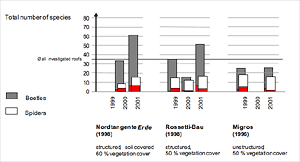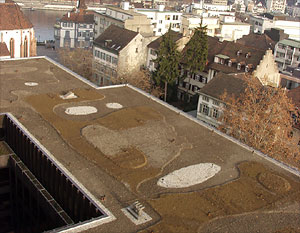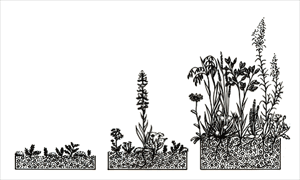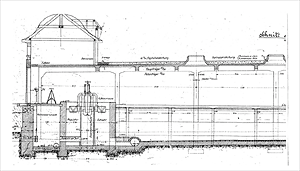Space for Urban Wildlife: Designing Green Roofs as Habitats in Switzerland
by Stephan Brenneisen
University of Applied Sciences Wädenswil, Grüental, Postfach 335, CH 8820 Wädenswil, Switzerland
Abstract
Research focusing on the biodiversity potential of green roofs has led to an amendment in building and construction law in Basel, Switzerland. As part of the city's biodiversity strategy, green roofs are now mandatory on new buildings with flat roofs, and guidance is provided for the creation of different plant and animal habitats on the green roofs. Design criteria for the creation of these habitats include varying the substrate thickness and using natural soils from nearby areas. (Studies of green roofs in Zurich, Switzerland, have shown that natural soils can benefit biodiversity through their suitability for locally and regionally endangered species.) The design and construction of green roofs to re-create habitats require close cooperation among all specialists involved. Research and comprehensive planning are also important for creating space on roofs for urban wildlife.
Key words: Basel; biodiversity; extensive green roofs; urban ecology; land-use regulations
Introduction
Extensive green roofs have generally been considered relatively species-poor alternative habitats for plants and animals, populated only by highly mobile pioneer species and unsuitable as permanent habitats for ground-dwelling organisms (Buttschardt, 2001). However, initial investigations in Basel, Switzerland, on a green roof set up as a dry pond and on an additional sample area have indicated that the low biotic diversity of many green roof surfaces is primarily due to their thin substrate layer (Brenneisen, 2003). A shallow substrate layer is the hallmark of current cost-conscious roof construction, but it exacerbates the already challenging conditions for plants and animals on green roofs. Methods have recently been developed to improve the design of building-integrated habitats for urban wildlife (Brenneisen, 2003).
Well-designed green roofs can provide habitat compensation for rare and endangered species affected by land-use changes. This has been established by research programs focusing on the ecological-compensation potential of extensive green roofs in Basel (Brenneisen, 2003) and London, England (Kadas, 2002; Jones, 2002). The results of these studies contrast with those of earlier studies from Germany, which found that only common, highly mobile species can establish on green roofs (Klausnitzer, 1988; Riedmiller, 1994; Mann, 1998). One reason for the differences in the results could be the varying numbers of individuals caught and identified. The survey in Basel collected 12,500 individual spiders, and this increased the statistical chance of finding rare species. Another reason could be that the research in Basel and London was carried out on green roofs with varying substrate thicknesses, which create different microhabitat conditions and greater potential for diverse suites of organisms to establish. On the Basel roofs, the vegetation ranged from geophytes and succulents (e.g., Sedum species) sparsely colonizing open areas to dense dry-herb and grass communities. On the most biodiverse roofs investigated, at the Rhypark building, a dense combination of microhabitats was found to support an assemblage of 79 beetle and 40 spider species. Thirteen of the beetle species and seven of the spider species were classified in Red Data Books (Platen, Blick, Sacher & Malten, 1996; Geiser, 1998; Pozzi, Gonseth & Hänggi, 1998) as endangered. A comparison of colonization rates on new roofs showed that the number of species of beetles and spiders increased over a period of three years on green roofs specifically designed for biodiversity, whereas approximately the same number of species were found on a conventional extensive green roof both three and five years after construction (Figure 1) (Brenneisen, 2003).
Click image to enlarge

Figure 1: Number of species of spiders and beetles on green roofs in Basel with structured and unstructured design, surveyed over a three-year period. Structured roofs were designed to increase faunal diversity. Red shading indicates species of conservation interest listed in the Red Data Book.
In addition to examining the influence of design on green roof biodiversity, the study also showed the importance of using natural substrates (Brenneisen, 2003). The adaptation of spider and beetle fauna to natural soil and other substrates such as sand and gravel from riverbanks seemed to be a factor for successful colonization. The results showed that near-natural habitats can be established on roofs. Compensatory microhabitats were constructed in Basel for invertebrates associated with riverbanks (Rossetti roof), with rocks and rock debris (Nordtangente roof), and with high mountain habitats and dry grasslands (Rheinfelden roof). Wet/dry meadows and heath/moor habitats can also be re-created on rooftops where there is restricted drainage combined with an appropriate amount and distribution of annual rainfall, or if the substrate provides sufficient water retention. An example of this habitat is the green roof system at the water-filtration plant in Wollishofen, on the outskirts of Zurich (Landolt, 2001).
Basel's Biodiversity Strategy for Green Roofs
Findings from this research have led to an amendment in the building and construction laws in Basel. Swiss land-use regulations stipulate that interference with the natural environment be kept to a minimum, and that soil be used in a sustainable way. Federal legislation on the conservation of nature and cultural heritage requires that endangered species be appropriately protected. In accordance with these regulations, the canton of Basel mandates the design and use of substrates for extensive green roofs as part of its current biodiversity strategy. In general, green roofs must be constructed on all new buildings with flat roofs (Nature and Landscape Conservation Act § 9; Building and Planning Act § 72). On roofs of over 500 square meters, the substrates must be composed of appropriate natural soils from the surrounding region and must be of varying depths.
Warm-Dry Regions
The Basel area is part of the central European mosaic of warm-dry regions and contains their typical flora and fauna. Figure 2 shows some of the habitat types associated with the area, which have been newly re-created on the green roof of the Cantonal Hospital of Basel. The substrate regimes on this roof ranged from gravel and sand (simulating river terrace conditions) to topsoil coverage (for near-natural dry meadows). The substrate depths were 6, 12, and 20 centimeters (Figure 3). The roof was seeded with a mixture of native annual and perennial herbs.
Moderate and humid climates
Appropriate green roof regimes have also been developed for landscapes in more humid climates. The four 90-year-old green roofs at the Wollishofen water plant in Zurich provide a good example (Landolt, 2001). The biological diversity of the surrounding area's species-rich wet meadows was conserved on these roofs after much of the habitat disappeared due to agricultural intensification. The original reason for installing the green roofs in 1914 was not for conservation but to cool the building and the water inside. Nonetheless, the roofs are now refuges for 175 recorded plant species, including 9 orchid species. Some of them, such as Orchis morio, O. latifolia, and O. militaris, are listed in Red Data Books and classified as endangered. The geobotanist Elias Landolt has recommended that the green roofs in Wollishofen be granted cantonal protection (Landolt, 2001). There are other green roofs where orchids or other rare and even endangered species could establish; however, the Wollishofen roofs are especially valuable because they sustain more or less entire plant communities known from the more natural habitats at ground level.
Natural Soil and Technical Substrates
The substrate on the roofs in Wollishofen is composed of 15 centimeters of topsoil from the surrounding area placed over a 5-centimeter layer of gravel (Figure 4). Water drainage is thus often limited on the Wollishofen roofs, and what is often perceived as a problem for an engineer becomes an opportunity for nature: Periods of high water retention alternating with dry periods reproduce conditions similar to those found in seminatural habitats such as moors and wet meadows. Such conditions were important factors in conserving typical local and regional biodiversity on the green roofs in Wollishofen.
In conclusion, although technical substrates (that is, substrates developed specifically for green roofs) have many practical advantages in terms of weight, consistent drainage, and efficient installation, they are generally suboptimal where biodiversity is concerned.
Implementation and Construction of Biodiverse Green Roofs
To implement the guidelines for green roofs under Basel's building and construction law, close cooperation is required between the local authorities and conservation scientists, as well as between structural and landscape architects, green roof companies, and contractors. To be successful, an urban biodiversity strategy for green roofs should be based on a regional research program that has investigated the opportunities for using green roofs as habitats and the specific conditions required by the species that would populate them. In addition, habitat and design concepts, as well as techniques for installing specific substrates on roofs, should be established.
Planning the creation of near-natural green roofs is highly challenging. Selection and storage of suitable substrates is crucial, as is determining the most suitable construction method. When redeveloping typical secondary urban habitats, such as those associated with brownfield sites and other valuable vegetated areas, the topsoil and/or substrate should be saved (if it is suitable) for subsequent use on a green roof. The top 15 centimeters of the substrate must be carefully removed and appropriately stored so that some of the existing vegetation, seed bank, and soil organisms can be conserved. Microhabitats can also be varied on green roofs by using substrates such as gravel and sand taken from layers under the soil of the construction site or from a nearby area. Landscape and construction planners should work together with the green roof company to decide on the best way of getting the substrate onto the roof and ensuring its efficient distribution over the total roof area. Careful planning and installation is time well spent, because a well-constructed roof can persist more or less carefree for over half a century, disturbed only by annual inspections of rooftop equipment and drains.
Replacement habitats have also been created on roofs in London (Frith & Gedge, 2000; Gedge, 2002). These include green roofs designed to mitigate habitat loss for the rare black redstart (Phoenicurus ochruros) and invertebrates associated with redeveloped brownfield sites.
Limitations of Green Roofs for Conserving Biodiversity
So far, I have emphasized the general ability of green roofs to protect species and nature. However, a supplementary study in the DB (German railroad) shunting yards in Basel (Brenneisen & Hänggi, 2006), which directly compared green roofs to areas of conservation importance on the ground, clearly showed the limitations of the roofs for supporting certain species. Some animals could not reach the green roof areas due to their restricted mobility—for example, Atypus species in the order of the web spiders (Araneae). Others simply did not visit (let alone colonize) the substitute habitats on the roofs. And still others could not adapt to or use the harsh environments of the roofs. Earthworms, or example, are unable to survive on green roofs due to the limited depth of the substrate; they perish during high temperatures in summer because they cannot migrate to deeper, cooler regions of the soil.
The size of the replacement habitat provided by green roofs is also a limiting factor. In the recent study (Brenneisen & Hänggi, 2006), the shunting yards cover several hectares and are thus in a different order of magnitude to a typical green roof, which may cover between a hundred and a few thousand square meters. The area of habitat needed by individual species for colonization then becomes the central issue.
Ground-Nesting Birds on Roofs
A further possible habitat function of green roofs is the provision of nesting locations for ground-nesting birds. Examples of this can already be found in the literature, particularly with regard to the little ringed plover (Charadrius dubius), northern lapwing (Vanellus vanellus), and skylark (Alauda arvensis) (Brenneisen, 2003). No long-term study of how a brood develops on flat roofs or whether flat roofs can actually sustain these species has been completed. However, because of the huge potential area for roof greening on industrial and commercial land on the outskirts of residential areas, it can be expected that consistent, extensive greening would lead to significant improvements for birds.
As part of the Ground-Nesting Birds on Flat Roofs project at the University of Applied Sciences Wädenswil, a number of green roof locations in Switzerland with possible breeding pairs of northern lapwing and little ringed plover are being observed and investigated. The investigations are focusing on how breeding takes its course on the roofs, whether young birds can survive, and, if necessary, how changes in the design of flat roofs can improve breeding success rates. (See Baumann, 2006).
Conclusion
Extensive green roofs can provide suitable habitat for animal and plant species that are able to adapt to and develop survival strategies for extreme local conditions and are also mobile enough to reach habitats on roofs. Unlike habitats on the ground, current green roof systems do not have deep soil layers; as a result, in extremely dry periods plants cannot draw up groundwater, and ground-dwelling animals have no opportunity to retreat to lower-lying, damper areas. Designing green roofs so that they have varying substrate depths and drainage regimes creates a mosaic of microhabitats on and below the soil surface and can facilitate colonization by a more diverse flora and fauna.
As a potential tool for preserving and restoring biodiversity in urban areas, green roofs need to be seen less from the perspective of ornamental gardening and energy conservation and more from a regional perspective of landscape and ecological planning. The functional and technical approach taken by most green roof developers and creators today can be enhanced by the spatial approach taken by conservation science practitioners.
Acknowledgments
The research and ongoing implementation of the construction laws and green roof practices in Basel could not have been so comprehensive without the continued support of Michael Zemp, Thomas Fisch, Marc Keller, and Barbara Schneider from the Department of Civil Works. My thanks also go to numerous architects and planners who supported the construction of various experimental green roofs. I want to give special thanks to Eduard Fries and Pascal Widmer, and Silvan Niggli with his working group for their help in planning and installing the latest, and up to now, largest "nature" roof in Basel. Thanks also to Mathias Eglin, organic farmer on the Asphof, near Rothenfluh, for his engagement in greening the roof of the stall for his 2,000 chickens.
I have also benefited greatly from the collaboration and exchange of ideas with researchers and specialists associated with the London Biodiversity Partnership, England: Dusty Gedge, Mathew Frith, Gyongyver Kadas, Jill Goddard, and James Farrell.



